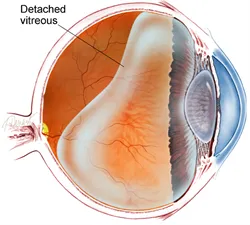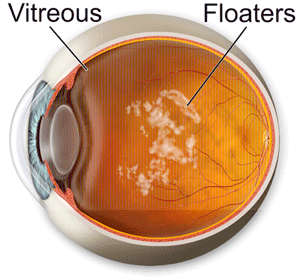What are Flashes and Floaters?
Most Flashes and Floaters are harmless but you won't know for sure without a thorough dilated eye exam with your ophthalmologist.
Floaters are small specks, dots, circles, lines or cobwebs in your field of vision. Often they will appear to float or move in your vision especially with eye movement. While they seem to be in front of your eye, they are actually floating inside. Floaters are tiny clumps of gel or cells inside the vitreous sac that fills your eye. What you see are the shadows these clumps cast on your retina . Floaters may be more visible to you against a solid color background like a blue sky or a blank wall.
As we age, the vitreous sac can loosen from it's normal attachments to the retina. This allows the sac to move freely in the eye resulting in more noticeable floaters. This process is called a posterior vitreous detachment or separation . These floaters typically fade and become less noticeable over a period of months.


You are more likely to get floaters if you:
- are nearsighted (you can see up close but need glasses to see far away)
- have had any eye surgery including cataract surgery
- have had inflammation (swelling) inside the eye
- have any history of trauma to eye or head in general
- most common cause is normal ageing, by age 65 50% of the population will have floaters
What are flashes?
Flashes are brief streaks or arcs of light in your peripheral vision lasting less than a few seconds. Often see in lower ambient light at night or when the eyes are closed. Flashes are caused by movement of the vitreous or jelly sac inside the eye. When the vitreous pulls on the retina we don't feel a pull we see a very brief flash of light. So the same process that can cause floaters can cause flashes and that's why it is so common to have both symptoms concurrently.
With a vitreous separation flashes usually take several weeks to disappear.
What is the Treatment for Floaters and Flashes?
Since floaters and flashes caused by vitreous separation is a normal ageing change and benign the only treatment necessary is an ounce of reassurance and a tincture of time. Most symptoms slowly improve over a period of several months. Unfortunately in some patients floaters can become chronic. Floaters and Flashes that worsen should not be ignored and usually require an additional dilated eye exam.
When are floaters and flashes serious?
Most floaters and flashes are not a problem. However, there are times when they can be signs of a serious condition such as a retinal tear or retinal detachment. Only a dilated eye exam can determine what is causing your floaters and flashes. Symptoms that suggest a retinal problem are:
- a sudden increase in old floaters or sudden onset of new floaters
- flashes of light that increase and move into the central vision
- a shadow or dark curtain that appears in your peripheral vision and progresses toward your central vision
- any loss of vision is always a concern and worrisome for a retina problem
If you are found to have a retinal tear or detachment it is always treated sooner rather than later.
Retinal tears often can be treated in the office with a laser
Retinal detachments require referral to a Retina Specialist and may require surgery in the operating room. (some types of retinal detachments can be repaired in the office)
